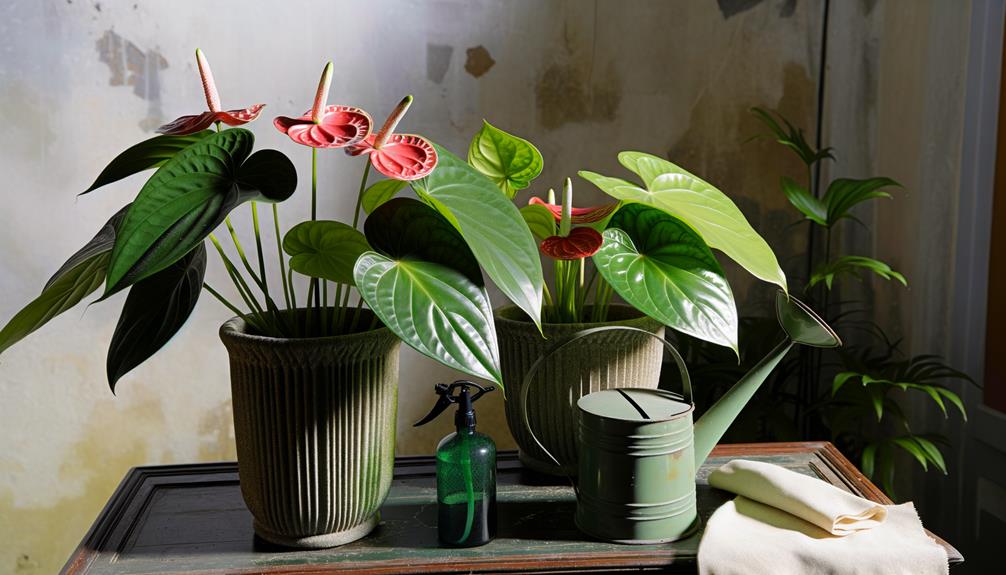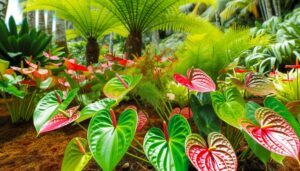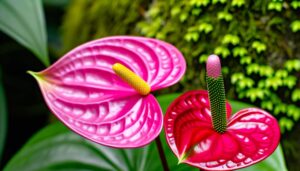7 Expert Tips to Care for Red-Flowered Anthurium Indoor Plants
To care for red-flowered anthurium indoor plants, position them in bright, indirect light and maintain temperatures between 65-80°F. Keep humidity levels at 60-80% using a humidifier or moisture trays.
Water every 1-2 weeks with distilled or rainwater, ensuring the soil is well-drained. Use a soil mix of pine bark, perlite, and peat moss.
Fertilize bi-monthly with a diluted, balanced liquid fertilizer during growth phases. Regularly inspect for pests such as aphids and spider mites, using natural predators or insecticidal soaps if necessary.
Prune to encourage healthy growth and rotate plants for balanced light exposure. For further expertise, stay tuned.

Key Takeaways
- Place anthuriums in bright, indirect light to prevent leaf burn.
- Maintain high humidity levels between 60-80% using a humidifier or misting.
- Water every 1-2 weeks with distilled water, ensuring soil drains well.
- Use a well-draining potting mix rich in organic matter like pine bark and perlite.
- Fertilize bi-monthly with a diluted balanced liquid fertilizer during the growing season.
Choose the Right Location
Selecting a best spot for red-flowered Anthurium indoor plants is important to guarantee sufficient light intensity and maintaining ideal temperature and humidity levels. Anthuriums thrive in bright, indirect light. Direct sunlight can scorch their delicate leaves, leading to chlorosis and reduced photosynthetic efficiency. Best placement is near east or north-facing windows, where light is filtered.
Temperature regulation is equally essential; these tropical plants flourish in environments between 70-85°F (21-29°C). Fluctuations below 60°F (15°C) can induce stress, inhibiting growth. Additionally, avoiding drafty areas ensures stable conditions. Consistent ambient temperature promotes cellular processes and metabolic function, critical for anthocyanin pigment production in red flowers.
Therefore, strategic placement is crucial for fostering a robust Anthurium.
Maintain Optimal Humidity
Maintaining ideal moisture levels between 60-80% is crucial for the health and vigor of red-flowered Anthurium indoor plants, as insufficient moisture can lead to desiccation and impaired physiological functions. Proper moisture ensures prime stomatal function and nutrient transport.
To achieve and sustain these moisture levels:
- Use a Humidifier: Employ a humidifier to consistently regulate the ambient moisture, particularly in arid environments.
- Mist Regularly: Gently mist the foliage with distilled water to mimic their natural tropical habitat.
- Group Plants: Positioning multiple plants together can create a microenvironment with higher moisture.
- Moisture Trays: Place pots on trays filled with water and pebbles, making sure the base of the pot is above the waterline to increase localized moisture through evaporation.
These strategies together enhance the microclimate, promoting Anthurium health.
Water Properly
Proper hydration is fundamental for red-flowered Anthurium indoor plants, as it directly influences their cellular turgor, nutrient uptake, and overall physiological resilience. Precise watering schedules are essential; overwatering can lead to root rot, while underwatering can cause dehydration stress. Utilize distilled or rainwater to avoid mineral buildup.
| Watering Criteria | Details |
|---|---|
| Frequency | Every 1-2 weeks |
| Water Quality | Distilled or rainwater preferred |
| Method | Thoroughly soak, then drain excess |
| Indicators of Need | Dry top inch of soil |
Monitoring soil moisture and environmental factors such as humidity and temperature will help in adjusting the watering regime, ensuring that the Anthurium thrives. Employ a moisture meter for precise readings to maintain ideal hydration levels.
Use Suitable Soil
Ensuring ideal growth for red-flowered Anthurium requires a soil composition rich in organic matter, featuring a blend of pine bark, perlite, and peat moss.
This mixture facilitates excellent drainage and aeration, essential for preventing root rot and promoting healthy root development.
Proper soil structure maintains the necessary balance of moisture retention and air flow, fostering robust plant health.
Ideal Soil Composition
Selecting a well-draining, nutrient-rich potting mix with a slightly acidic to neutral pH is essential for the best growth of red-flowered Anthurium indoor plants. The optimal soil composition guarantees sufficient moisture retention while preventing root rot and promoting healthy growth.
Here are key components:
- Peat Moss: Provides excellent moisture retention and helps maintain a slightly acidic pH.
- Perlite: Enhances aeration and drainage, essential for preventing waterlogged conditions.
- Pine Bark: Adds organic matter, improving nutrient availability and soil structure.
- Charcoal: Absorbs impurities and helps maintain soil freshness, reducing the risk of root diseases.
These elements collectively create an ideal environment for red-flowered Anthuriums, ensuring strong health and vibrant blooms.
Drainage and Aeration
Effective drainage and aeration are crucial for preventing root rot and promoting robust growth in red-flowered Anthurium indoor plants. Utilizing a well-draining, aerated soil mix is essential to achieve this.
A recommended medium involves a blend of orchid bark, perlite, and peat moss in equal parts. Orchid bark enhances aeration, while perlite improves drainage, ensuring excess moisture does not accumulate around the roots. Peat moss provides a stable, moisture-retentive environment that supports nutrient uptake.
Additionally, incorporating activated charcoal can further enhance soil structure and prevent microbial growth. Ensuring the potting medium remains airy and non-compacting is essential for maintaining root health and optimizing plant vigor. Regularly check and amend the soil to maintain its ideal properties.
Fertilize Regularly
Regular fertilization is vital for sustaining the vibrant red blooms of Anthurium plants. Implementing an ideal fertilizer frequency, typically bi-monthly, guarantees a consistent supply of essential nutrients.
Utilizing a nutrient-rich soil mix further enhances the plant's growth by providing a balanced medium for nutrient absorption.
Optimal Fertilizer Frequency
To maximize growth and vibrant blooms in red-flowered anthuriums, applying a balanced liquid fertilizer every four to six weeks is crucial. This frequency guarantees that the plants receive an adequate supply of essential macro and micronutrients, which support overall plant health and flowering potential. A balanced 20-20-20 (N-P-K) formulation is recommended.
Key considerations include:
- Dilution Ratio: Always dilute the fertilizer to half the suggested strength to prevent root burn.
- Application Timing: Fertilize during the growing season (spring and summer) when the plant's nutrient uptake is at its peak.
- Watering Practices: Water the plant lightly before and after fertilization to assist nutrient absorption.
- Monitoring: Regularly observe the plant for signs of nutrient deficiencies or excesses, adjusting the frequency accordingly.
Nutrient-Rich Soil Mix
In addition to a balanced fertilization regimen, cultivating red-flowered anthuriums in a nutrient-rich soil mix significantly enhances their overall growth and blooming performance.
The ideal substrate should comprise well-draining components such as orchid bark, perlite, and peat moss, ensuring adequate aeration and moisture retention. A pH range of 5.5 to 6.5 optimizes nutrient uptake, while organic matter like compost can supply essential micronutrients.
Regular amendments with slow-release fertilizers, rich in nitrogen, phosphorus, and potassium, sustain prolonged nutritional availability. Ensuring a symbiotic relationship between soil microorganisms and the plant roots further promotes robust growth.
This holistic approach to soil management is essential for maintaining the vibrant hue and longevity of the anthurium's red flowers.
Prune for Health
Pruning red-flowered anthurium is necessary for maintaining plant health and promoting robust growth. Effective pruning involves removing dead or damaged leaves and spent flowers, which can otherwise deplete the plant's resources and attract pathogens.
To achieve best results, follow these steps:
- Sterilize Tools: Always use sterilized pruning shears to prevent the spread of diseases.
- Identify Targets: Focus on cutting away yellowing, brown, or wilted leaves, as well as faded flower stalks.
- Make Clean Cuts: Ensure cuts are clean and precise to avoid harming healthy tissue and to encourage faster healing.
- Regular Inspection: Conduct pruning sessions regularly, ideally every few weeks, to keep the plant in top condition.
Monitor for Pests
Regularly checking your red-flowered anthurium for pests is crucial to preventing infestations that can jeopardize its health and well-being. Common pests include aphids, spider mites, and mealybugs.
Examine the plant's leaves, stems, and roots carefully, focusing on the undersides of leaves where pests usually gather. Early detection is essential; use a magnifying glass for a more detailed inspection.
For biological control, introduce natural predators such as ladybugs or predatory mites. If chemical treatment is needed, choose insecticidal soaps or neem oil, which are less harmful to the plant.
Ensure proper airflow and avoid overwatering, as excessive humidity and stale air can worsen pest issues. Regularly tidying up the plant's surroundings will also discourage pest reproduction.
Conclusion
In summation, the meticulous care of red-flowered anthurium indoor plants is crucial for their flourishing. Selection of a perfect location, maintenance of appropriate humidity levels, and precise watering are necessary.
Implementation of suitable soil, regular fertilization, and strategic pruning further contribute to plant health. Vigilant monitoring for pests guarantees sustained well-being.
Adhering to these expert recommendations will greatly enhance the aesthetic and biological prosperity of anthurium plants, thereby ensuring their continued exuberance and ornamental value.






